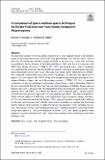Files in this item
A comparison of sparse and non-sparse techniques for electric-field inversion from normal-component magnetograms
Item metadata
| dc.contributor.author | Mackay, Duncan Hendry | |
| dc.contributor.author | Yeates, Anthony | |
| dc.date.accessioned | 2021-12-09T11:30:36Z | |
| dc.date.available | 2021-12-09T11:30:36Z | |
| dc.date.issued | 2021-12-08 | |
| dc.identifier | 274856507 | |
| dc.identifier | a9402329-2f09-4ad5-a78f-5dcd1eba4cf1 | |
| dc.identifier | 85120868811 | |
| dc.identifier | 000728176900001 | |
| dc.identifier.citation | Mackay , D H & Yeates , A 2021 , ' A comparison of sparse and non-sparse techniques for electric-field inversion from normal-component magnetograms ' , Solar Physics , vol. 296 , no. 12 , 178 . https://doi.org/10.1007/s11207-021-01924-z | en |
| dc.identifier.issn | 0038-0938 | |
| dc.identifier.other | ORCID: /0000-0001-6065-8531/work/104618879 | |
| dc.identifier.uri | https://hdl.handle.net/10023/24495 | |
| dc.description | Funding: D.H.M. would like to thank both the UK STFC and the ERC (Synergy grant: WHOLE SUN, grant Agreement No. 810218) for financial support. D.H.M. would like to thank STFC for IAA funding under grant number SMC1-XAS012. ARY thanks STFC for support under grant ST/5000321/1. | en |
| dc.description.abstract | An important element of 3D data-driven simulations of solar magnetic fields is the determination of the horizontal electric field at the solar photosphere.This electric field is used to drive the 3D simulation and inject energy and helicity into the solar corona. One outstanding problem is the localisation of the horizontal electric field such that it is consistent with Ohm’s law. Yeates (ApJ, 836, 131, 2017) put forward a new “sparse” technique for computing the horizontal electric field from normal component magnetograms that minimises the number of non-zero values. This aims to produce a better representation of Ohm’s law compared to previously used “non-sparse” techniques. To test this new approach we apply it to active region (AR) 10977, along with the previously developed non-sparse technique of Mackay, Green and van Ballegooi-jen (ApJ, 729, 97, 2011). A detailed comparison of the two techniques with coronal observations is used to determine which is the most successful. Results show that the non-sparse technique of Mackay, Green, and van Ballegooijen (2011) produces the best representation for the formation and structure of the sigmoid above AR 10977. In contrast, the Yeates (2017) approach injects strong horizontal fields between spatially separated, evolving magnetic polarities. This injection produces highly twisted unphysical field lines with significantly higher magnetic energy and helicity. It is also demonstrated that the Yeates (2017) approach produces significantly different results that can be inconsistent with the observations depending on whether the horizontal electric field is solved for directly or indirectly through the magnetic vector potential. In contrast, the Mackay, Green, and van Ballegooijen (2011) method produces consistent results using either approach. The sparse technique of Yeates (2017) has significant pitfalls when applied to spatially resolved solar data, where future studies need to investigate why these problems arise. | |
| dc.format.extent | 29 | |
| dc.format.extent | 4726879 | |
| dc.language.iso | eng | |
| dc.relation.ispartof | Solar Physics | en |
| dc.subject | Sun: corona | en |
| dc.subject | Sun: magnetic fields | en |
| dc.subject | Sun: modelling | en |
| dc.subject | QA Mathematics | en |
| dc.subject | QB Astronomy | en |
| dc.subject | QC Physics | en |
| dc.subject | NDAS | en |
| dc.subject.lcc | QA | en |
| dc.subject.lcc | QB | en |
| dc.subject.lcc | QC | en |
| dc.title | A comparison of sparse and non-sparse techniques for electric-field inversion from normal-component magnetograms | en |
| dc.type | Journal article | en |
| dc.contributor.sponsor | Science & Technology Facilities Council | en |
| dc.contributor.sponsor | Science & Technology Facilities Council | en |
| dc.contributor.sponsor | European Research Council | en |
| dc.contributor.institution | University of St Andrews. Applied Mathematics | en |
| dc.identifier.doi | https://doi.org/10.1007/s11207-021-01924-z | |
| dc.description.status | Peer reviewed | en |
| dc.identifier.grantnumber | N/A | en |
| dc.identifier.grantnumber | ST/S000402/1 | en |
| dc.identifier.grantnumber | 810218 | en |
This item appears in the following Collection(s)
Items in the St Andrews Research Repository are protected by copyright, with all rights reserved, unless otherwise indicated.

